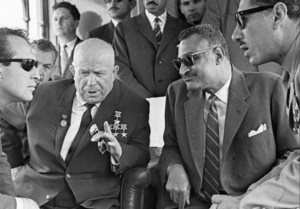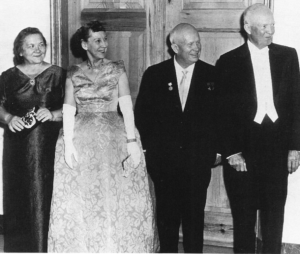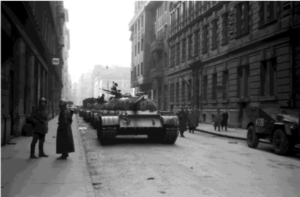
Twin World Crises
“We couldn’t, on one hand, complain about the Soviets intervening in Hungary, and, on the other hand, approve of the British and French picking that particular time to intervene against Nasser,” Richard Nixon.
October/November 1956 was a crazy time. No less than two earth-shaking events were taking place, both intimately involving the Soviet Union and the balance of world power rested on the reactions of the West to the reactions of the East. Both the Suez and Hungary were roiling in independent and yet interconnected crises.
“At 8 o’clock we decided to emphasize Suez and yet, another half-an-hour later, Hungary was ahead. And then it changed,” Andre Fontaine, the editor-in-chief of the Foreign Policy Column of Le Monde.

The reactions of the United States and Soviet Union were key in both conflicts. The responses in the bi-polar rivalry depended – whatever their outward rhetoric – on their knowledge of the limitations on power. Neither was prepared to push the other side into a massive conflict over territorial control that could not be sustained. However, both were adamant that they would not lose territory (a policy that became known as the Brezhnev Doctrine in the Soviet Union). The twin crises of 1956 were key in showing both the United States and the Soviet Union the limits of power on each side.

One the one side, the United States directed an enormous flow of encouragement and rhetoric into Hungary via Radio Free Europe, giving many Hungarians hope that an American intervention would be forthcoming. In fact, official American response was to both assure the Soviets in a statement by President Eisenhower himself that the United States did not consider Hungary a potential future ally and to send word to the Soviets via a telegram to Yugoslavia’s Tito that the United States would not be pleased to see anti-Soviet nations on the border of the Soviet Union. Apparently the American intelligence community, caught on the back foot by the Hungarian Revolution, had upped its game enough to know that a secret meeting between Khrushchev and Tito was about to go down.

On the other hand, the United States responded with an indignant and forceful promise to other Soviet overtures. The US threatened to use the nuclear option against the Soviet Union if Moscow carried out any threatened retaliation in London and Paris. The indignation was directly related to Moscow’s invitation for the US to join the USSR against the UK and France.
On the Soviet side, bombastic rhetoric aside, actual Soviet military action in the Suez, where Western powers had ready access to all that was needed to run a war, was in short (nonexistent) supply. Overwhelming military action was the word of the day on Soviet borders in Hungary, however.

In short, everyone now knew where everyone else’s limits lay. In the span of two months at the end of 1956, the parameters of the Cold War were set.
To read the rest of our ongoing series about the Hungarian Revolution of 1956, click here.
- November 27, 2020
- History
